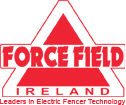

Please Note - Feel free to contact us on the numbers above for no obligation help
With fast moving animals such as horses, two or three lines of highly visible tape or rope is recommended for an electric fence. For ponies the top line should be around 1m high and for horses, the top line should be around 1.4m. Every horse is different but a rough guide is around nose height.Used in conjuction with electric fencing plastic posts, they can provide an effective strip grazing solution giving an area of fresh grass daily. This allows for control over the animals grass input therefore helping to manage conditions such as laminitis.
Sheep / GoatsThree lines of rope, tape or wire run through plastic posts at heights of 25cm, 50cm and 75cm is ideal although sheep netting is ideal to contain non-horned sheep and lambs. Electric sheep nets are becoming more popular due to their mobility.
It is important to choose a powerful energiser when containing sheep as firstly, they are very well insulated and secondly, when using netting every 50m roll has 7 x 50m conductors needing powered.
Beef cattle need a visible fence so a couple of lines of tape, rope or twine are the ideal choices with the top line about 120cm high.
Dairy cattle will only need one line of tape, rope or twine at 1m to contain them.
Poultry netting is the obvious choice here. These are very mobile and spare posts can be bought seperately for uneven ground.
Please be aware when choosing your energiser that nets are very 'power hungry'. For every 50m of netting, the energiser has to power 11 x 50m horizontal lengths.
As pigs have very little hair to insulate them, they respond very well to electric fencing and learn to respect it quickly and three lines of wire or twine is adaquate for strip grazing purposes.
In paddocks containing piglets it is becomming increasingly popular to use 50cm high netting (rabbit netting) in order to contain the more adventurous piglet.
50cm high electric rabbit netting is the ideal solution for keeping both pests out and pets in.
Please be aware when choosing your energiser that nets are very 'power hungry'. For every 50m of netting, the energiser has to power 8 x 50m horizontal lengths.
50cm high netting (green) is the ideal solution for keeping both pests out and pets in.
Please be aware when choosing your energiser that nets are very 'power hungry'. For every 50m of netting, the energiser has to power 8 x 50m horizontal lengths.
Smaller dogs are best contained with netting (50cm or 75cm high) but larger dogs tend to respond well to a few lines of electric tape. The height of this is determined by how high the dog can jump.
Herons / Pond ProtectionEither two lines of polytwine or 50cm high netting will deter herons from a garden pond provided that it's positioned between 12 - 18 inches from the waters edge. This is because herons always land a few feet from the water's edge but walk down into it.
Always make sure that the connections between the electric fence energiser and the cables is secure and that there are no loose connections anywhere. The fenceline conductors should have to appropriate connectors joining them. This will ensure that the power from all the conducting wires is transferred to all the wires in all subsequent wires.
Make sure that there is no vegetation touching the electric fence as this will cause the power to leak to earth rendering the fence less effective. Where the fence runs close the the ground it would be advisable to strim regularly or spray with weed killer.